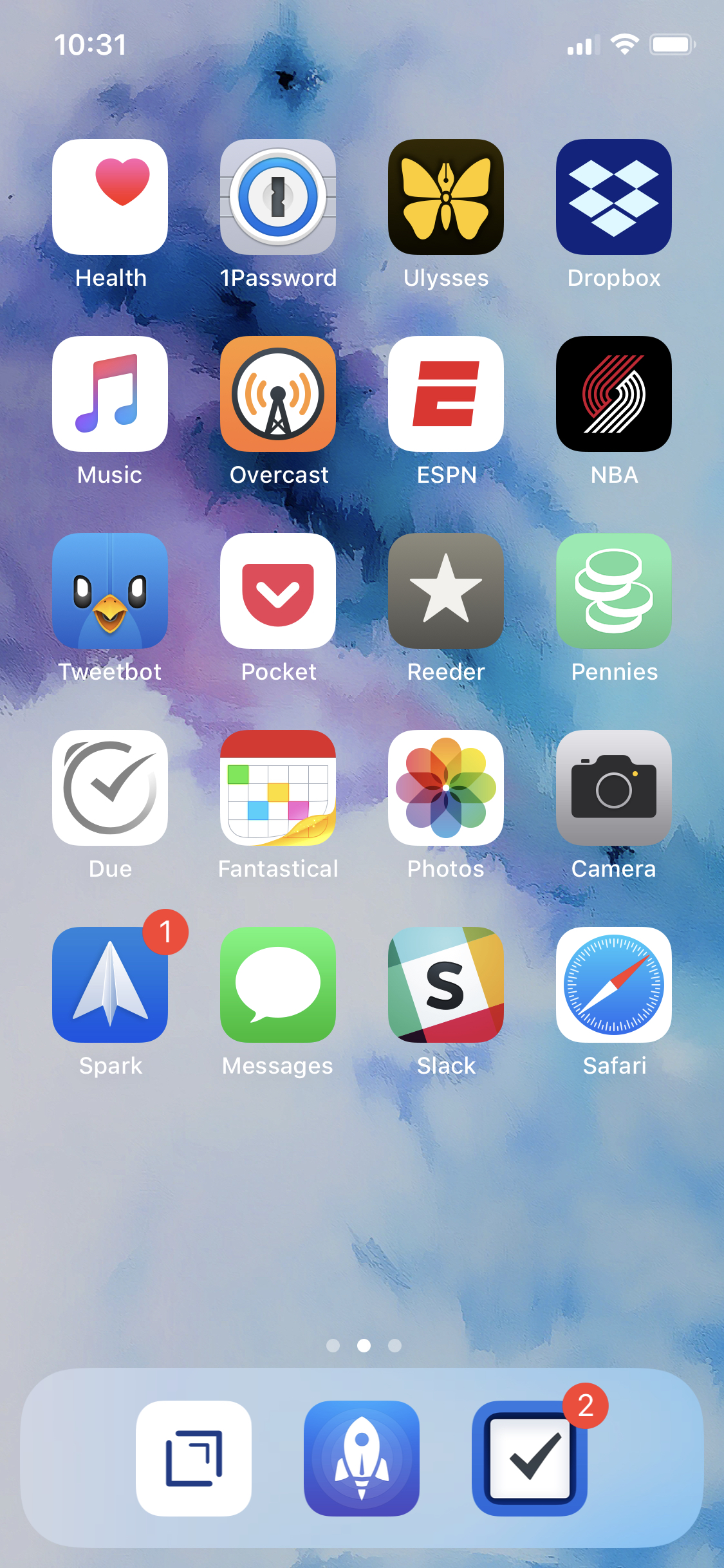If everybody always lies to you, the consequence is not that you believe the lies, but rather that nobody believes anything any longer. This is because lies, by their very nature, have to be changed, and a lying government has constantly to rewrite its own history. On the receiving end you get not only one lie — a lie which you could go on for the rest of your days — but you get a great number of lies, depending on how the political wind blows. And a people that no longer can believe anything cannot make up its mind. It is deprived not only of its capacity to act but also of its capacity to think and to judge. And with such a people you can then do what you please.
GoRuck Having a Sale
GoRuck are having a sale. They’re the best backpacks in the world and I really like their packing cubes as well.
Sign Up for My Newsletter
Like my blog?
Subscribe to my Liner Notes newsletter.
It goes out once a week, on Fridays, and it’s filled with the same sort of stuff I’ve been writing or sharing in my blog for years. However, now it’s in one easy to digest and read newsletter. There’s music thoughts, movie thoughts, a ten song playlist of music I’ve loved each week, and recommendations and cool shit I’ve seen online.
There’s no spam, I won’t ever sell your email address to anyone, and I think you’ll like it. Subscribe here.
Democrats Are Hoping You Don’t Understand What “Impeachment” Entails
Democrats who preemptively declare impeachment off the table are mistakenly (or intentionally) conflating one possible end result of the impeachment process for the process itself. The Republican members of Congress who voted to open an impeachment inquiry into Nixon’s conduct didn’t necessarily want it to end in his removal from office; even up until his resignation it was an open question whether there were enough votes in the Senate to remove him. They were trying to get at the truth about the administration’s actions, and using impeachment to gather evidence. (They didn’t even limit themselves to Watergate. The committee eventually also voted on whether to impeach Nixon for the illegal bombing of Cambodia and for failure to pay taxes.)
All of this.
When Winter Never Ends
Wright Thompson, writing for ESPN:
Ichiro is a meticulous man, held in orbit by patterns and attention to detail. This place specializes in beef tongue, slicing it thin by hand and serving it raw alongside hot cast-iron skillets. They do one thing perfectly, which appeals to Ichiro. Tonight he’s got dark jeans rolled up to the calf, each leg even, and a gray T-shirt under a white button-down with a skinny tie. His hair looks darker than in some recent photos, maybe the lighting, maybe a dye job. Either way, not even a 44-year-old future Hall of Famer is immune from the insecurities and diminishments that come with time. This winter is the most insecure and diminished he’s been.
The Optimism of Uncertainty
Howard Zinn, writing in 2016:
I have tried hard to match my friends in their pessimism about the world (is it just my friends?), but I keep encountering people who, in spite of all the evidence of terrible things happening everywhere, give me hope. Especially young people, in whom the future rests. Wherever I go, I find such people. And beyond the handful of activists there seem to be hundreds, thousands, more who are open to unorthodox ideas. But they tend not to know of one another’s existence, and so, while they persist, they do so with the desperate patience of Sisyphus endlessly pushing that boulder up the mountain. I try to tell each group that it is not alone, and that the very people who are disheartened by the absence of a national movement are themselves proof of the potential for such a movement.
Craig Manning’s Top Albums of 2018
I’m never sure what to write at the outset of this post. How do you sum up an entire year in a few paragraphs? It was a big year in my life, marked by a move back to my childhood hometown and a few big leaps forward in my professional life. I was busier, which left less time for discovering new music and less time for writing about it. Still, 22 of the 40 artists on the list below have never featured on a year-end list of mine in the past, and two of my top three albums are debuts. I always like knowing that there is new talent on the horizon, artists that might morph from big surprises this year to favorite artists a few years down the line. 2018 was a wonderful year for that kind of discovery.
In terms of my favorite music, I was all over the map in 2018. I leaned a little less on country than I have for the past few years, though there are still plenty of country and Americana artists on this list. Mostly, I was looking for songwriting that spoke to where I am at this current moment in my life. A lot of what resonated spoke of nostalgia and the past, a fitting theme given that I’ve been out of high school for almost 10 years now. I thought a lot about growing older in 2018, and about the shifting chapters of my life. The music, from Andrew McMahon’s “House in the Trees” to Lori McKenna’s “People Get Old” to Donovan Woods’ “Next Year,” told me that I wasn’t alone in feeling what I was feeling. As I get further from high school, I’m constantly wondering if I’ll get to a point where I’ll stop relating to music in the fiercely personal, autobiographical way that I always have. It’s a comfort to know that hearing the right song at the right time still feels as potent and poignant as it did when I was 17.
I’m rambling, as I always do at the start of these posts. So, I think I’ll stop now and let the 40 albums listed below speak for themselves.
Adam Grundy’s Top Albums of 2018
When I look back on the year of music that was 2018, I can’t help but marvel at the great mix of variety and strength of material that came out of it. From polished singer-songwriter material to stadium ready anthems, this year had it all. Here is my list of the 30 albums that had the biggest impact on me:
Jason Tate’s Top Albums of 2018
Another year is in the books, and I must say, this was one of my favorite years for music in a long while. I felt like I was discovering new music, or a new album to fall in love with, on a regular basis. And then the albums that ended up connecting with me, really hit me. It’s comforting to know that even when the rest of the world can feel like a mess, music still can find a way to cut through and make things feel a little better, if only for the duration of a great song.
After much deliberation, I’ve put together my favorite music, movies, tv shows, books, and apps from the past year. I’ve included playlists where appropriate, and I hope you’ll find something that will connect with you the way it has me.
Introducing Chat Sematary
It took me much longer to get around to writing something up on my new podcast than I intended, but here we are. Chat Sematary is my new Stephen King podcast. I’m breaking down his bibliography and many of the adaptations that followed. As of right now, I have roughly 10 episodes in the bag and four that you can listen to now (five if you want to include the trailer).
For the most part, I’ll be experiencing a lot of his novels for the first time. I had read a handful out of order when I first started reading his works and then I decided to start from the top and run through them in the order of release. That led me to the idea for this podcast and it’s going to be a lengthy process. Right now, there are roughly 150 episodes to plan out. That number will change as King continues to release novels, short stories, and novellas and as more adaptations come out.
If you’re a King fan, even in the slightest, you just might find something to enjoy with this podcast. I’m not going to claim to be an expert on his works and how everything ties in, but I’m having a lot of fun discussing everything. I’m also always open to having new guests on the podcast, so if you or anyone you know might be interested, get in touch with me on Twitter.
You can find the podcast on Transistor to listen and subscribe and on Twitter and Instagram. There’s even a thread for both of my shows on the Chorus.fm forum.
Home Screen Icon Creator
I’ve always been intrigued by Workflow’s implementation of ‘Add to Home Screen’ – a feature that Apple kept in the transition to the Shortcuts app, and which allows users to create home screen icons to launch their favorite shortcuts. So earlier this month, I decided I wanted to learn how Shortcuts was handling the creation of home screen icons.
After a few weeks of experiments and refinements, I ended up reverse-engineering Shortcuts’ ‘Add to Home Screen’ implementation, which turns out to be an evolution of Workflow’s existing hack based on Safari and web clips.
Federico Viticci and I must have been playing around with this stuff at the same time. His implementation and solution is way better.
The Best RSS Reader for iOS
I did a deep dive into RSS readers for iOS over the weekend.
Creating a Simple App Launcher With a Custom Icon for iOS
In iOS 10 Apple introduced the ability for app makers to offer alternative app icons for their apps. A few of my favorite apps have taken advantage of this. Overcast has a cool dark icon for subscribers, Carrot Weather has a huge selection to choose from, and the MLB At Bat app lets you pick your favorite team’s logo as the icon. It’s a nice way to add a little bit of customization to your device. However, not every app has taken advantage of this new feature. For example, it’s a no brainer that the NBA should copy baseball and let you put a team logo as the app icon … but, they don’t. So when it came time to move from having the MLB app on my home screen, to the NBA, I started looking into all the different ways I could maybe change-up the icon. I have no desire to jailbreak my phone and this really isn’t an app I open up all that often anyway. I check it maybe a couple times a day, at most, to see what games are on, check scores, and watch one via League Pass if it’s coming down to the wire. Because of this, I thought about just using a Siri Shortcut to act as an app launcher and being done with it, but I didn’t love how the shortcut would launch, then switch to the Shortcut app, and then launch the NBA app. Sure, it worked, but it took longer than I wanted to even for an app I only open a few times a day.
However, I realized that if there was only one slight pause and a redirect to the NBA app, without first going through Shortcuts, that would probably work just fine for what I wanted this to do. So I took a look at how Shortcuts was creating these launchers and realized they’re basically just Web Clips that when opened redirect to a Shortcuts URL scheme. Looking a little closer I saw they created these Web Clips in a pretty clever way that kept everything local on the device. Usually a Web Clip will launch Safari and hit a web site, which is slow, however, if it’s a local HTML file it doesn’t need to do anything at all. So I copied their technique.
I created a basic HTML file that redirects to the NBA url scheme, created the icon I wanted for it, turned the background black, and then added a startup image that displays the logo on a black background. That way, when I tap the icon, instead of just getting a brief white background, I get a cool all black Trail Blazer screen before being sent to the NBA app. There’s still a slight delay, but it’s passable this time, since I’m sent right to the app and not to Shortcuts first.
And it means I can have the Blazer logo on my home screen:

If anyone is interested in how I did it. Here’s the basics: I started with a simple HTML document.
<html> <head> <title>NBA</title> <meta http-equiv=”Content-Type” content=”text/html; charset=UTF-8″> <meta name=”viewport” content=”width=device-width, initial-scale=1.0, maximum-scale=1.0, user-scalable=no, viewport-fit=cover” /> <meta name=”apple-mobile-web-app-capable” content=”yes”> <meta name=”apple-mobile-web-app-status-bar-style” content=”black”> <meta http-equiv=”refresh” content=”0;URL=’nba://'” /> <link rel=”apple-touch-icon” href=””> <link rel=”apple-touch-startup-image” href=””> </head> <body style=”background: #000;text-align: center;”> <img src=”data:image/png;base64,” width=”175″ style=”position:fixed;top:47%;left:49.2%;transform: translate(-50%, -50%);”/> </body> </html>
The meta refresh tag I set to the NBA URL scheme. I told the Web Clip to be full-screen (apple-mobile-web-app-capable). Set the status bar to black to match the background (apple-mobile-web-app-status-bar-style). (Change “black” to “default” to make it white.) And set the icon (apple-touch-icon) and the start up image (apple-touch-startup-image) to their respective images (you can find the recommended sizes via Google depending on what device you use).
Now, in the middle of the screen I wanted to show the Blazer logo. However, I didn’t want this image to be hosted on a server somewhere and slow down my little launcher. So, I recommend optimizing your image as much as possible and then converting it to Base 64. Grab that code and set it as the source for the image. I tweaked the size and positioning so that on load the start-up image and my little website thing would look the exact same.
After that I borrowed how Siri Shortcuts adds home screen apps. Convert the entire HTML page to Base 64. You’ll get a giant string representing your Web Clip. Mobile Safari won’t let you just copy and paste this into your browser, so you’ll need to link it from somewhere. I created a page that just had one link on it:
<a href=”data:text/html;base64,”>click me</a>
After the comma, I put the giant base 64 string. I tossed that on my server, opened it on my phone, and clicked it.
(I’m sure you can use something like this to do that too.)
It opened up the HTML page I created and asked if I wanted to be redirected to the NBA app. I clicked cancel, then just created the home screen app like usual (share sheet, add to home screen). I tapped the icon, it showed my startup screen, and then the NBA app opened up. Exactly like any of the Siri Shortcut apps and all without having to jailbreak my device or create a custom profile on the phone. Just a basic local HTML page turned into a web clip. I’d never do this for any app I open all the time, but this use case is just about perfect.
I share other things like this in the Apple thread from time to time.
Oh. And go Blazers.
Does the Seasonal Timing of an Album Release Have a Direct Impact on Its Eventual Success/Failure?
One of the things I have been pondering about over the past few weeks is why record labels would want and/or prefer to release a Summer-themed record in the Fall. Maybe they would like for an album to be considered for year-end awards such as the Grammy’s, or for an artist to fulfill a contractual obligation during a calendar year? Taking a quick look at some of the noteworthy Fall releases this year, we can see several high-profile and established artists such as: Thrice, The 1975, Coheed & Cambria, Saves the Day, and Twenty One Pilots.
Judging by the singles released from these artists during the Summer, The 1975, Saves the Day and Twenty One Pilots’ albums may have been more thematically poised for immediate success if they were released in June or July. Other artists such as Thrice and Coheed seem to “fit” with the Fall themes, judging solely on what I have heard from the released music. I still expect the Twenty One Pilots and The 1975 albums to be hugely successful regardless of when they were released, however, these albums will genuinely marinate and sink into our consciousness throughout the rest of 2018 and bleed into the Winter of 2019. The question I am posing is, what makes an album with a clear thematic season attached to it get the album release date that eventually helps or hinders its eventual success?
For starters, let’s use the example of a well-received Fall-themed record in AFI’s, Sing the Sorrow. Any guesses on what date this album hit the streets? March 11, 2003. For a record so synonymous with autumn and the “Silver and Grey” that goes along with the changing of seasons, the timing of this release seemed a little odd. Yes, AFI became a major household name after the success of Sing the Sorrow, but if the record label had strongly considered the themes found throughout the album, many of us might have had an easier time digesting this classic LP. The first single released from that album was “Girl’s Not Grey,” which sounded like a solid punk rock Summer jam, but again, why release that single back in the dead of Winter before the album’s eventual release in March?
It only gets stranger when you look at AFI’s subsequent release, Decemberunderground, that had a release date of June 6, 2006. Really? You have yet another chance to own the Winter and all the snowy packaging surrounding AFI’s second major-label effort, and you ship it off to the stores in the Spring. Sure, the first single of “Miss Murder” was hitting the airwaves towards the end of Winter in March or so, but this seemed like another missed opportunity to take full advantage of the themes surrounding the album.
On the other side of the coin, what happens when a bonafide Summer record drops in the Winter? Look no further than what happened to Andrew McMahon and the Wilderness on their sophomore release Zombies on Broadway. A February 10th release date, in my opinion, truly detracted away from the hype and buzz surrounding this Summer-themed album. Even my colleague, Craig Manning, made these points in his album review by explaining how so many of these songs are built for a long Summer drive, similar to the Everything in Transit album. I can’t exactly blast “Island Radio” with the windows down if I have to scrape the ice off of my car first.
Lastly, what happens when the label gets it right? Yellowcard’s Southern Air hit the record shelves on August 13, 2012, and it went on to be one of their most well-received records from both critics and fans alike. Whether or not the timing of the release had a lot to do with its success can continue to be debated for years to come. I’d like to think that labels such as Hopeless Records honestly get what their artists are trying to accomplish and can continue to market their bands in meaningful ways.
Most labels have been relying for far too long on their algorithms and other formulas of what makes an album a success or failure. If the labels would stop to consider the art they are helping release to the masses before they set a release date in stone, they may be surprised by the short-term (and long-term) reaction each LP gets. Or, maybe they would be better served to include the artists in their decision-making processes so that everything “clicks” at just the right time. For argument’s sake, let’s try and bring some of the creativity back to the art of the album release date and its associated packaging.
The Beautiful, Ugly, and Possessive Hearts of Star Wars
I don’t care if you liked or didn’t like something. You are absolutely entitled to your opinion. But the opinion is not what matters. The point is that when you say something is “bad writing” or “bad direction,” I want to understand what you actually mean by that, and why you think that. And if you can only stammer out a few confusing words that add up to “that’s how I felt,” then I can’t understand you. And the simple truth is that applying the right words and backing them up with clarity, while showcasing an understanding of the nuance behind them, is literally what criticism is. Which is precisely why I take so much issue with critical culture trying assign a specific kind of value judgement, just because we think that’s what we’re supposed to do.
Amen.











